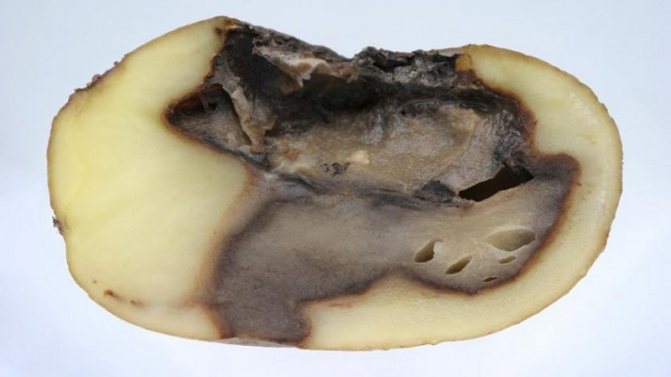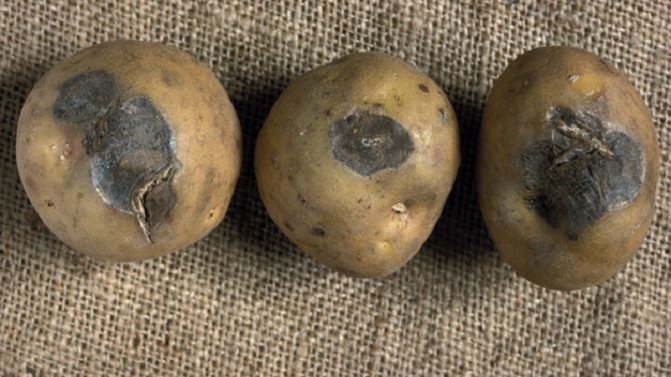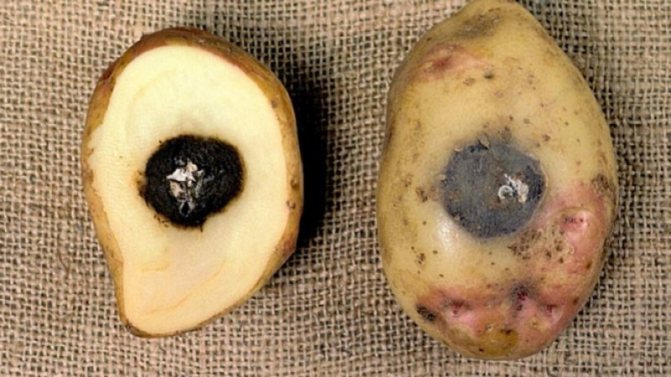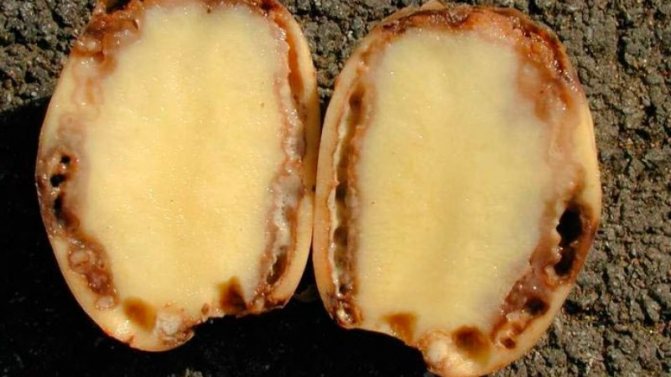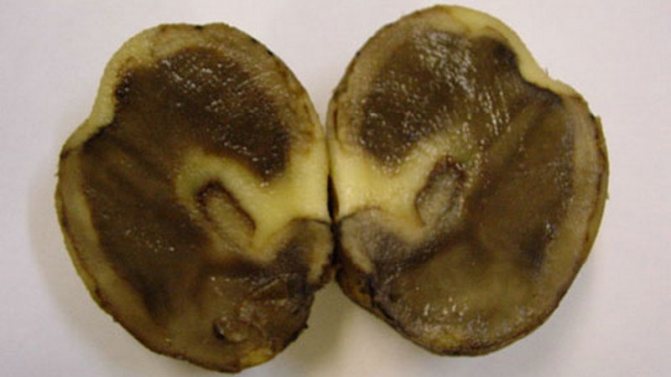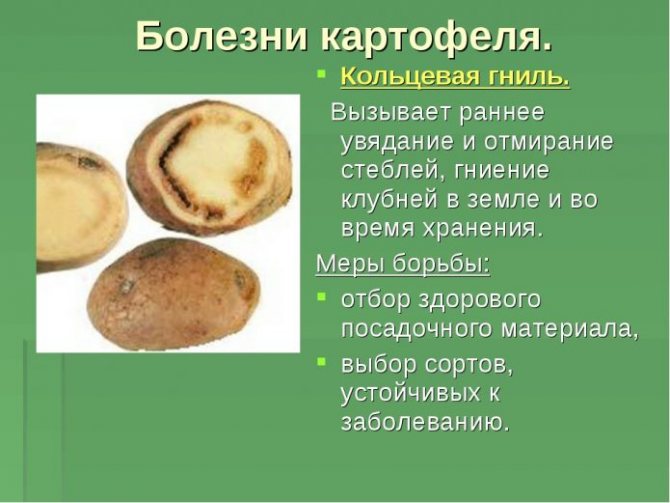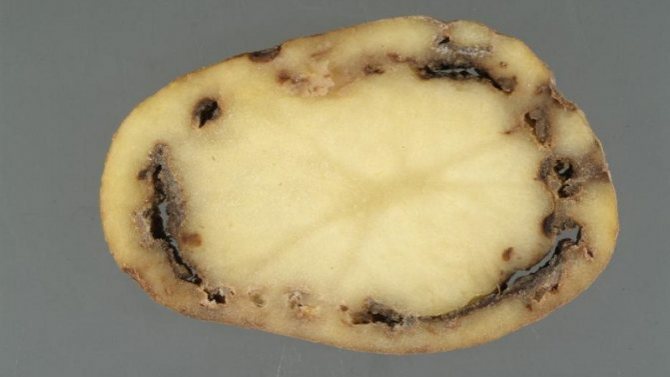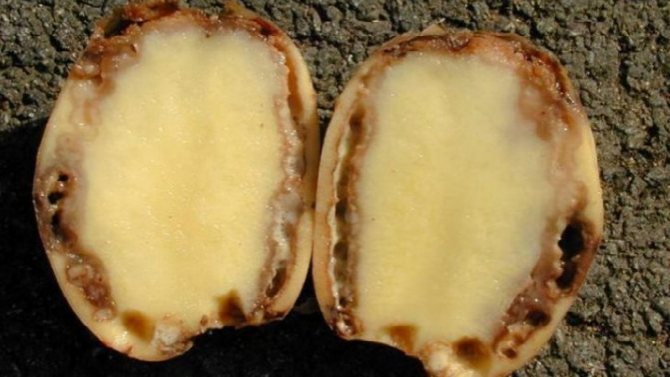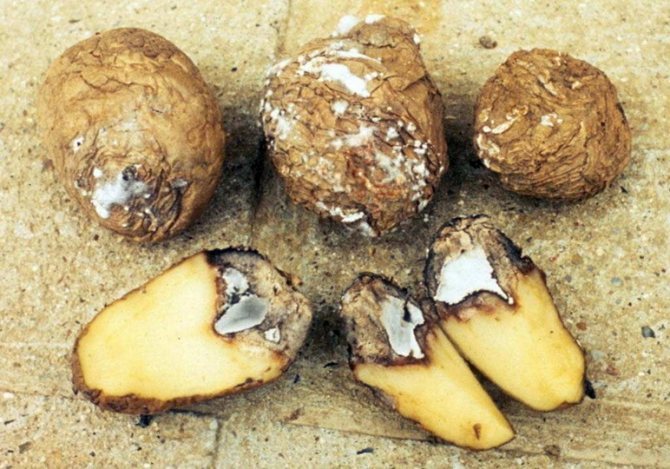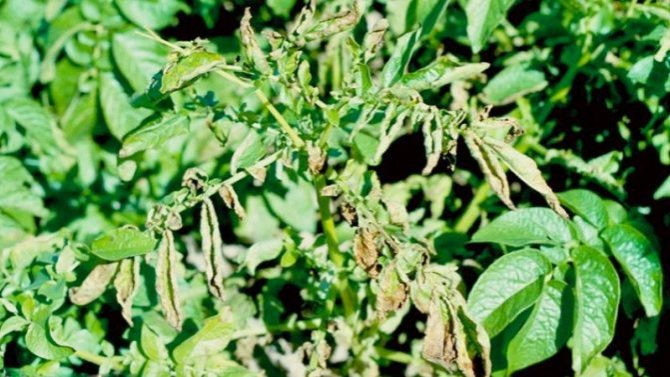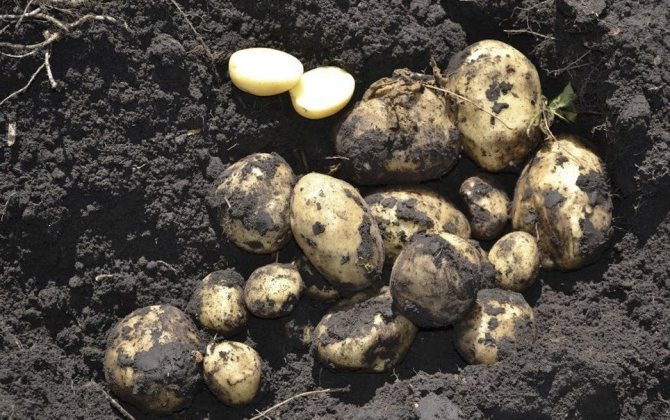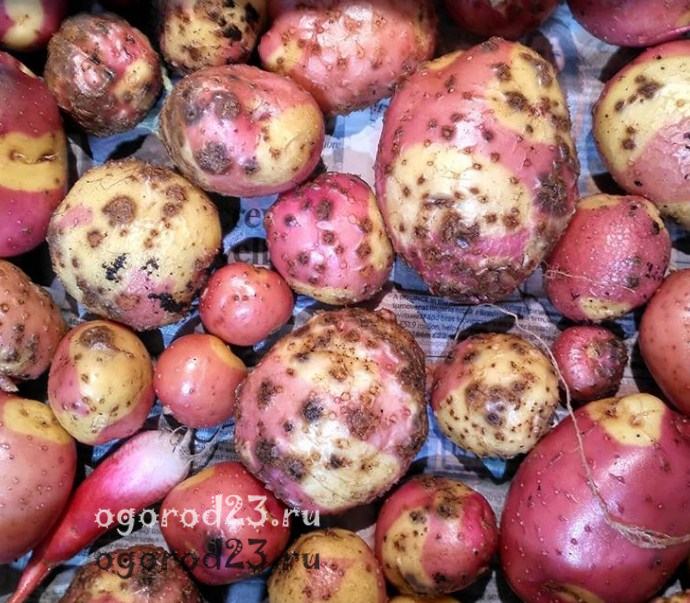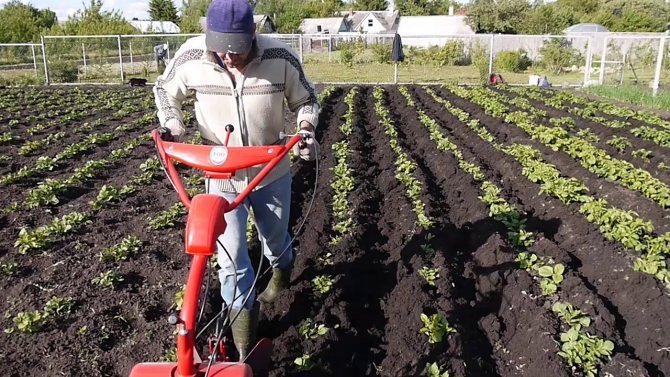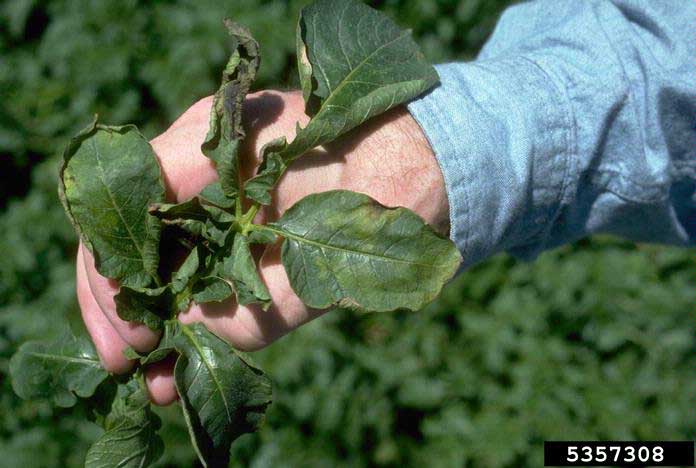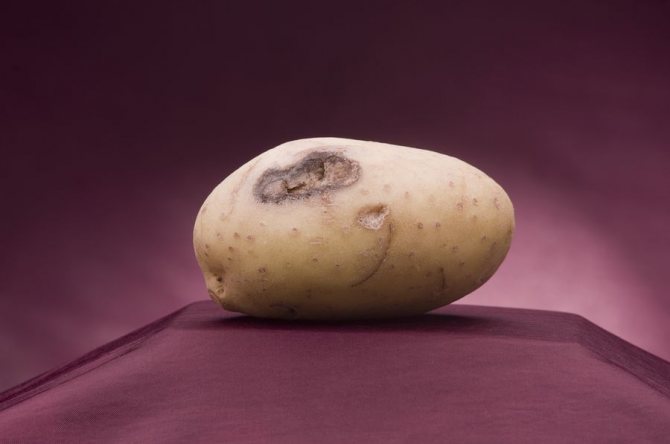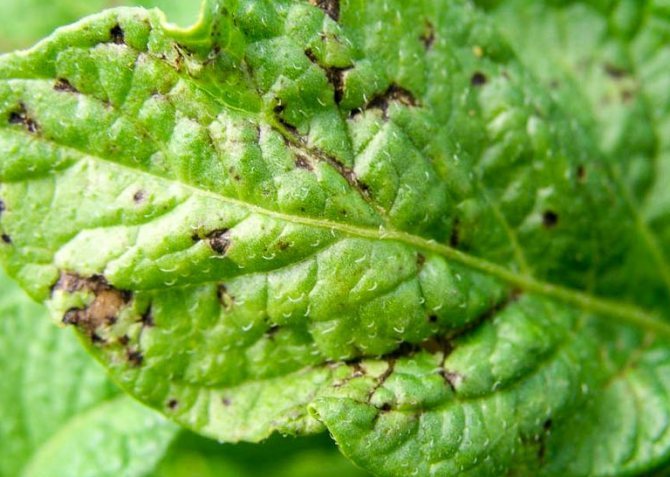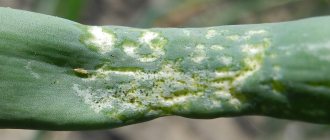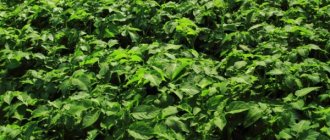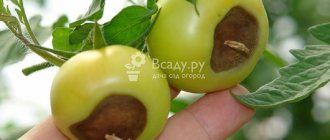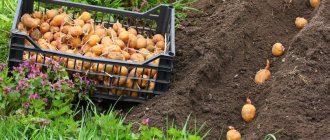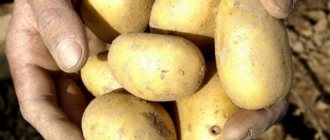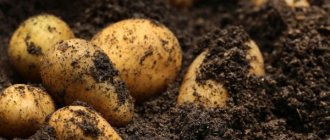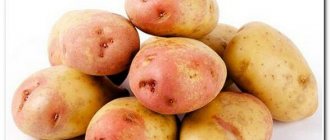Diseases of vegetable crops, in general, are an unpleasant thing, and when there are still no special pesticides to fight diseases, this does not add optimism to most gardeners. Nevertheless, bacterial diseases of potatoes can and should be learned to cope, since they are widespread and can destroy up to half or more of the annual harvest.
Ring rot of potatoes is just one of the bacterial diseases and is found everywhere in all territories where potatoes are grown. The disease is insidious, since its symptoms develop rather slowly and are not immediately noticeable from the outside, although crop losses can be up to 40-45%. In this article, you can find a photo of the signs of the disease, as well as its description and methods of treatment. It is only necessary to immediately understand that in the case of ring rot, treatment as such is usually not carried out. Infected plants are subject to immediate destruction - they cannot be saved. But the prevention of the disease plays a very important role.

Potato ring rot causative agent
Ring rot of potatoes is considered practically one of the most dangerous diseases of this root crop. If detected late, you can lose about 40-45% of the total harvest, since the disease is very widespread.
The causative agent is a harmful bacterium of the species Corynebacterium sepedonicum (Clavibacter michiganensis subsp. Sepedonicum), belonging to a variety of aerobes. These bacteria are straight or slightly curved rods with rounded edges. They can be single, chained or paired. The infection spreads very slowly and unnoticed at first. Infection occurs from old infected family tubers by penetration along the trunks and stems of the pathogen.
The withering of the aboveground part of the vegetable crop occurs due to the accumulation of a large number of bacteria in the trunks, which clog the vessels of the plant, blocking the path of all vital microelements. Due to the lack of nutrients, the leaves lose their turgor and begin to wither gradually. Some researchers also associate the wilting of potatoes with the release of phytotoxic substances by bacteria.
Control measures
It is ineffective to treat dry fusarium rot on potatoes. Preventive measures must be taken to prevent the spread of the disease.
Location on
In order to avoid the spread of the disease, potato bushes must be periodically inspected. Having found diseased specimens, do not hesitate to remove them from the soil. It is recommended to burn affected tubers and tops. Do not put them in a compost heap.
Proper care of agricultural crops can reduce the likelihood of dry rot on plantings. Plants must be weeded in a timely manner, the soil under them must be loosened. Such simple techniques allow you to prevent waterlogging of the soil and thickening of the bushes. It is in a humid environment that the fungus multiplies rapidly.
Since the causative agent of a dangerous disease penetrates the tubers through wounds, you should not plant potatoes with mechanical damage (from a pitchfork, shovel, pests). Such roots are used either for cooking or as feed for livestock.
In the underground
For long-term storage, it is worth selecting exceptionally healthy roots, without any damage. Beforehand, they must be thoroughly dried and kept in the light for one to two weeks, you can in a barn.
The main causes of rotting potatoes in the ground
Why does potatoes rot from the inside? The main reasons are:
- violations in agricultural technology - excessive watering, absence or, conversely, excessive loosening, irregular weeding;
- non-observance of the rules of crop rotation - this applies to rot with a fungal etiology;
- use of diseased inoculum.
What is the source of infection
A source of fungal rot infection become affected tubers and spores remaining in the soil, rot of bacterial origin - infected tubers. In both cases, an additional source may be diseased tops left in the soil or used as compost.
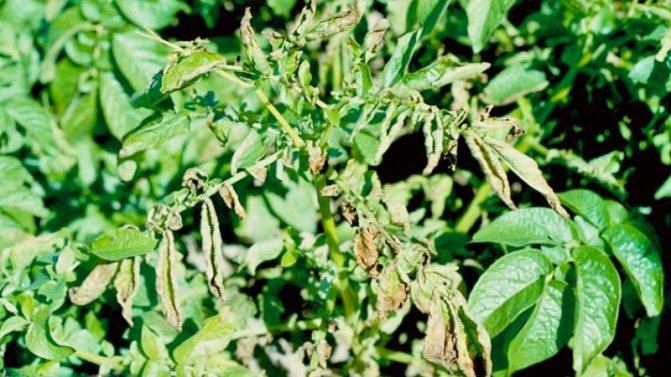

Ring Rot Bush
Causes of the disease
The main source of potato infection with such a disease as ring rot is the very same tubers of this plant. At the time of planting, when an infected tuber gets in, the disease begins to spread first along the grown bush, and then passes to nearby growing plants. The infection spreads especially quickly if tubers are damaged in the form of scratches and cracks.
As a rule, bacteria do not survive in the ground, they are replaced by soil antagonists. But in plant residues, as well as in tubers, rot can remain for a long time.
Attention! According to some reports, the causative agent of ring rot can stay for a long time in cold rooms on surfaces where infected tubers were located.
What is dry rot?
Everyone can imagine wet rot, because all organic substances are subject to the decay process to one degree or another. Why is the disease affecting mainly potato tubers called "dry rot"?
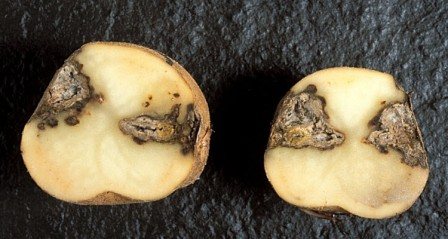

Description of the disease
This disease, along with scab and late blight, is quite widespread throughout Russia. Fusarium, or dry rot, is caused by fungi of the genus Fusarium. If, when viewed on a tuber, you find depressed spots of a dark color, covered with dry skin on top, then this is a sure sign of fusarium. Later, under this spot, all the pulp dries up, it becomes rotten, and in the resulting voids you can see the mycelium - mycelium with ripening spores.
The onset of the disease can be determined already by the state of the tops. Before flowering, the upper leaves on a potato bush first brighten and then begin to wither. The stem at the bottom turns brown and the whole plant begins to dry out. As a rule, the fungus captures several bushes, localizing in a small area. Noticing such signs on a potato field, it is worth immediately digging up and burning all the affected bushes, and spilling the vacated area with a solution of potassium permanganate or boric acid.


Is the fungus dangerous for humans?
Dry rot of potatoes is one of the most dangerous diseases for it. It spreads quickly, and spores infect tubers not only in the ground, but also during winter storage, because they are easily transferred along with the ground. Some believe that tubers that have some kind of mechanical damage are infected first of all, but this has not been proven. Also, favorable conditions for the development of this disease on the site are considered to be a high content of nitrogen in the soil or too abundant fertilization with manure, especially fresh.
This type of fungus does not have a direct effect on the human body, but it is not recommended to eat tubers affected by dry rot. Therefore, ruthlessly discard all tubers that have even the initial signs of damage, already when sorting out potatoes in the basement.
Prevention of potato diseases
Fungal diseases affect the tops and tubers of the plant, actively develop in conditions of warmth and high humidity, spreading their spores everywhere, even to inventory and planting material. The danger of these diseases also lies in the fact that they make the culture very vulnerable to other diseases.
This fungal disease most often affects tubers, as well as roots and stems that are underground. It is for this reason that, before digging up the crop, it is difficult to notice any signs of infection and prevention plays an important role. Potatoes infected with scab lose much in the quality of tubers, and, accordingly, in taste, are poorly preserved.
- Common scab most often appears on red potatoes with thin skin and hard ulcerative formations of irregular geometric shape. Scab develops in calcareous soils, with a pronounced lack of moisture, at temperatures of 25-30 ° C.
- Silver scab appears on scarlet potatoes with wrinkled skin and silvery inclusions. Favorable factors are an air temperature of about 20 ° C, high humidity, loamy soil. An important difference between this fungal disease of potatoes is not putrefactive processes during storage, but a strong loss of moisture and mass of tubers.
- Powdery scab affects tubers, roots and stems in the ground. Spores of this fungus spread quickly and spoil the entire crop. Infected potatoes lose moisture, weight and quickly rot when stored in high humidity conditions.
The disease develops in lands with excess water, at temperatures of about 20 ° C.
Symptoms - gray-white growths, various spots and ulcers, in which spores are visible, are visible on the peel.
A cool and humid spring is a favorable factor for the development of this fungal disease. Heavy and frequent precipitation, temperatures below 18 ° C, affect the development of the disease. The loss of potato yield from rhizoctonia is up to 40%.
Symptoms are all kinds of black spots on the skin of the tubers, reminiscent of uncleaned soil. Diseased plants are lethargic and low, with curled leaves. Rot appears on the seedlings, and in some cases the seedlings die and, accordingly, the bush dies.
The level of harm caused by rhizoctoniae depends on the following factors: the amount of the fungal pathogen in the soil, the quality of the planting material, the density of planting, the type of soil, the level of soil acidity.
Phytophthora is considered the most important cause of crop loss, with alarming numbers of up to 75%. The condition of the soil, temperature parameters, and geographical area have almost no effect on the development of this fungal disease. It manifests itself to a greater extent on tubers, but also captures the tops. A persistent fungal pathogen, getting into the soil, infects tubers.
After infection with late blight, spots appear on the stems and leaves of seedlings during the growing season. The main signs can be noticed before harvest and take all the necessary measures to combat brown rot.
Symptoms:
- Brown, over time darkening spots on the leaves of the plant.
- Whitish bloom on the inside of the leaves.
- The tubers are gradually covered with gray spots.
- In the state of active development of the potato disease, hardening spots are noticeable on the tubers, on the cut - dead areas of a dark color with a rusty tint, spreading throughout the entire volume of the tuber.
This disease affects both the upper part of the plant and the potato tubers. The main symptoms are: brown spots, darkening over time and tubers with large dark depressed wrinkled spots. The yield loss can be up to 25%. The disease is most susceptible to mid-season varieties.
Powdery mildew
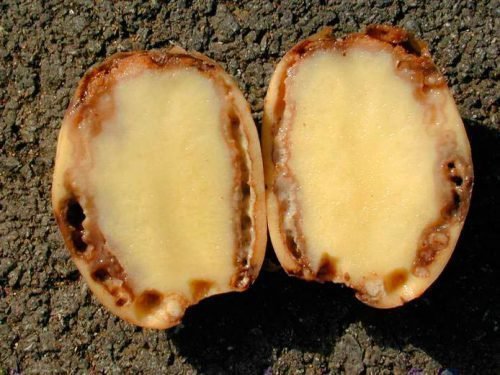

This disease is favored by high humidity and temperature, so powdery mildew is especially widespread in southern latitudes.
The upper parts of the plant, stems and leaves are more affected by the disease, due to which the tubers do not receive proper development.
The main symptoms: Rounded spots of small size, brown with a whitish bloom, clearly visible from the back of the leaves.
The fight against this disease is expressed in the radical destruction of the foliage.
For treatment, the bushes are sprayed with a solution of soda ash. When the first symptoms are detected, it is possible to treat potato plantings with sulfur preparations.
This fungal disease is common throughout our country. Crop losses are calculated in figures up to 40%. The fungus lives in the upper layers of the soil, affects the tops, and does not allow the tubers to develop to a productive condition. The disease develops very rapidly, within three to four days the plant dies. Therefore, it is important to take action when detecting the slightest symptoms!
Symptoms:
- During the flowering period, the first signs appear - the upper leaves turn yellow and fade. In hot weather, it seems that the plant does not have enough moisture. If the weather is cool, then the leaves do not fade, but curl.
- In the lower parts of the stem, there is a pink-orange bloom. The affected part of the stem rots quickly.
- The disease develops very quickly, the plant dies.
If the disease affects tubers, then this disease of the potato tuber is called fusarium rot or dry rot. If at least a few infected potato specimens got into the planting material, then this can cause a yield loss of up to 15%.
The first signs of damage to a vegetable by dry rot when laying for storage appear after a couple of months. Typical dents with wrinkled skin and multi-colored spots (from pink to orange) with spores of the causative agent of a fungal infection appear on the tubers. Potatoes become infected from each other, the pulp of the tubers is completely replaced by fungal mycelium, and they dry out completely.
Verticilliasis
This disease is also called potato verticillus wilt. It manifests itself during the flowering period of the plant, wilting of the leaves. In the initial phase of the disease, the leaves turn yellow from the edges, then they become covered with brown spots with a yellow border, a grayish bloom appears. Infected plants stunted, wither and die. Crop losses can be up to 50%.
Many potato diseases, from decay of planting material to crop failure, are caused by bacterial infections.
Read more: Tomato oak characteristic and description of the variety unique features
"Blackleg"
This bacterial infection affects the potato crop in the vicinity of the cabbage planting. Yield losses reach 70%.
The main symptoms: in early development, yellowing and folding of the lower leaves, then rotting of the lower part of the stem, which easily breaks off, the tubers first soften, then completely rot.
Ring rot
This disease is a dangerous bacterial infection that affects potatoes. The whole plant suffers, and in the upper part, and the tubers. Crop losses up to 45%.
The main symptoms: Often the tubers are healthy on top, putrid rings on the cut. The stems of the plants turn yellow, a yellowish liquid is squeezed out of them.
Bacterial cancer
A very dangerous disease of potato tubers, manifested by tubercles in the area of the eyes, which, as the disease progresses, turn into large ugly dark growths.
This infection, also called wilt, was recently described in our country. But its coverage area is wide enough. Warm weather and high humidity are favorable factors. Loss of yield up to 50%.
The main symptoms: sudden wilting of plantings within a few days, starting with yellowing of the leaves and ending with death from decay.Tubers on the cut have soft rotting rings, from which liquid is squeezed out.
Diseases caused by viruses are very common and dangerous in that they almost never manifest themselves in the initial stages. It is worth familiarizing yourself with the most famous of them in order to maximize the safety of the future harvest from these diseases.
Rolling the leaves
The disease affects both the tops of the plant and the tubers. Favorable factors for the development of viral infection are high temperatures and insufficient soil moisture. The disease is transmitted by aphids. Loss of yield up to 50%.
The main symptoms are the curling of the leaves into a tube. They become brittle so that they crack when touched. Tubers in the section have reticular manifestations of necrosis in the form of cracks and germinate for a long time.
Mosaic virus
Mosaic virus refers to a whole group of potato diseases that affect both the upper parts of the plant and the tubers. Diseases differ in the degree of harm they cause, and if the disease is triggered, the crop dies. The infection is spread by aphids, and infection with already diseased plant specimens is also possible.
Symptoms of the mosaic virus group of diseases (wrinkled, banded, ordinary, marbled): The disease begins to manifest itself from the lower leaves with all kinds of spots. The spots turn into areas of necrosis. Rotting gradually rises up the stem, the lower leaves fall off, the bush takes on the appearance of a "palm tree".
Tuber necrosis
The disease is caused by the tobacco rattle virus. This is a clear disease of the potato tuber, causing its necrosis. The spread of the virus goes through infected tubers and through infected soil. Crop losses up to 40%.
The main symptoms: The disease begins to manifest itself from the upper leaves with all kinds of spots. The spots turn into areas of necrosis. Rotting gradually descends down the stem, the upper leaves are deformed. On the same bush there can be both infected shoots and healthy ones. On the tubers: on the peel - areas of necrosis, similar to a cork, on the cut - areas of death in the form of circles and rings. Even in autumn, potatoes are no longer in a marketable form.
The deformations that the tubers infected with the virus acquire affect the presentation of the potato and a decrease in yield.
The main symptoms: the first signs - a bright blue or purple color appears at the edges of the leaves. The leaves become small and narrow. Tubers acquire a specific spindle-shaped shape.
The resources spent on planting, growing, harvesting potatoes, efforts and resources will be wasted if your crop, when laid on a permanent storage place, overtakes diseases. We described in detail above about late blight, fusarium rot, black scab and bacterial infections that cause strong processes of rotting and drying of tubers during storage.
Signs of potato ring rot
When heavily infected tubers are planted, some of them completely rot, while others germinate. In this case, the first signs of infection appear early. The surface of the sprout leaves takes on a pale yellow tint between the veins, so the leaves begin to appear speckled from the side. Gradually, the upper leaves of the potato sprout completely turn yellow, in some cases, even curl up. The leaves located at the bottom begin to wither slowly, become very thin and almost lifeless. A shortening of internodes can also occur, which leads to a dwarfism of the potato bush.
If, during planting, the potato was slightly infected, the germination of the plant increases, and the signs of the disease appear much later. The first symptoms of ring rot in this case appear only at the time of flowering of the potato. During the flowering period, 1-2 stems from infected bushes gradually wilt.Then the ends of the leaves turn yellow and curl to one side.
Attention! One of the clear signs of ring rot is that the stems quickly fade and fall to the ground, as they lose turgor due to vascular blockage.
Ring rot on tubers can be recognized by the appearance of a vascular ring and a yellow subcutaneous spot. When pressed on the potato, a light yellow, liquid mass is released from the affected area. In the photo below you can see how a potato tuber affected by ring rot looks like.
How to identify the disease?
Check out these articles as well
- Currant variety Dobrynya
- Why laying hens do not rush
- The benefits and harms of cherries for humans
- Tomato variety Banana legs
Ring rot can neigh both the underground part of the potato (tuber) and the ground part (tops) throughout the entire period of growth and maturation of the crop.
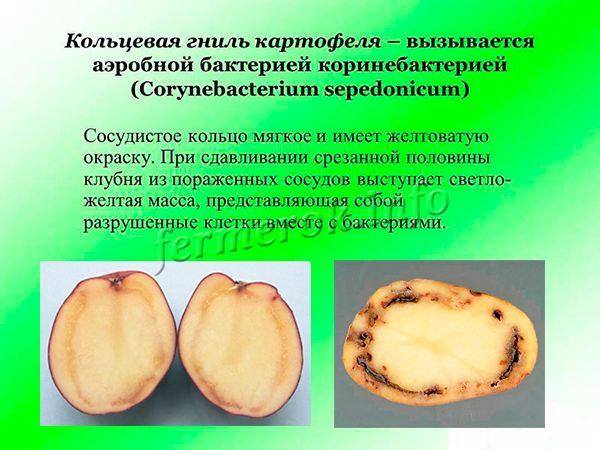

The main signs of the disease are yellowing and wilting of the tops, rotting of tubers.
The main signs of the disease are yellowing and wilting of the tops, rotting of tubers. Decay is slow and easy to identify. If you cut a potato, you can see a ring formed by a bacterium, it is located above the skin. The skin of the affected potato is usually soft and may release a yellow, slimy substance when pressed.
Fomoz of potatoes
Another equally unpleasant disease of this vegetable crop. It is also called button rot or phoma disease. Phoma exiqua, the causative agent of the fungus, provokes potato phomosis. Its spores are parasitic on stems and tubers. They are transferred from a diseased plant to a healthy plant by airborne droplets. In addition, fungal spores can live in the soil and penetrate the cells of roots, stems and leaves with rainwater.
Disease manifestations
There are three forms of phomosis:
- stem;
- stolon;
- tuberous.
The stem form of the disease begins to actively manifest itself at the end of the flowering period. Small necrosis appears on the stems, turning into spots 10 cm long, which gradually spread around the entire circumference. As a result, the stem breaks off and perishes.


In the stolon form, potato stolons are affected. Superficial dark brown spots turn into deep ulcers, while the affected parts of the roots die, and the rest do not produce many potatoes.
The tuberous form is the most common. The first signs of the disease appear only 3-4 weeks after harvest. Sometimes active decay begins after 6-7 months, already in the spring, when the planting material is planted in the ground. These potatoes do not germinate, they completely rot. First, dark, hard, slightly depressed spots form on the skin. They gradually increase in depth and along the perimeter. Outwardly, it looks as if the pulp has been pressed in with a button. The surface of the ulcer is dry, papery. If you press on it with your finger, it will crumble into powder. This is the mycelium of the pathogen with black dots of pycnidia.
Treatment of the disease
Fomoz of potatoes is a fungal disease, so it needs to be treated with the same drugs as fusarium. It is important to suppress the foci of the disease, improve the conditions for winter storage of the crop and regularly prevent infection of tubers.
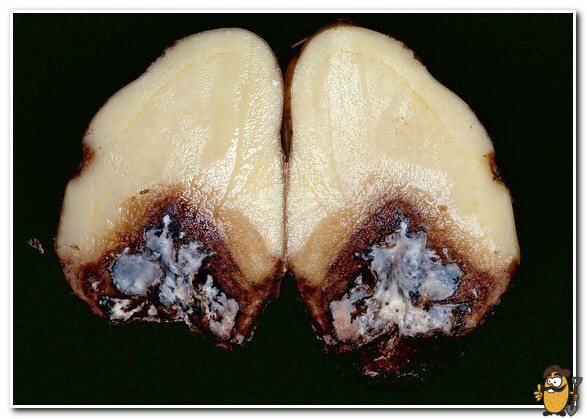

Fomoz of potatoes: control measures
Simple measures will help prevent the mass spread of mushroom spores. Crop rotation will reduce the percentage of spores of the pathogen in the soil. To prevent the stem form of phomosis from spreading to the tubers, the tops must be cut 10 days before the expected harvest. In the spring, before planting, it is necessary to carefully sort out the seed potatoes and mercilessly remove all spoiled specimens. The stems should be sprayed with fungicides before flowering. Before laying potatoes in a cellar or basement, the storage must be removed, the walls must be whitewashed with lime, and the racks must be washed with disinfectants. Thanks to these measures, potatoes will never be affected by button rot.
Fusarium potato
This dangerous disease, also called dry rot, affects many vegetable crops. Fusarium of potatoes is provoked by the pathogen Fusarium oxysporum. This is a type of spore fungi that live in the ground, on plant debris and on the skin of tubers. The pathogen penetrates into plants with rain moisture through the root system. As soon as the spores begin to develop actively, the formation of fusarium occurs.
- planting seed potatoes infected with fungal spores;
- improperly prepared soil;
- violation of storage conditions for tubers;
- rejection of crop rotation on the site for several years;
- adverse weather conditions;
- excessive pest attacks;
- lack of organic matter and mineral fertilizers in the soil.
The most dangerous period of manifestation of the disease is the time of active formation and development of young tubers. A month after infection, the first signs of the disease appear. Visually, you can see the following symptoms:
- leaves curl at the top of the bush;
- the stems change color, acquire a brown tint;
- leaves begin to turn yellow, crumble, dry;
- stems droop to the ground, rot.
- fusarium of potatoes on tubers appears as dry brown or gray-brown spots (rot);
- the skin of the potatoes becomes wrinkled, voids form inside the tuber.
- the structure of the tuber core changes (it becomes dry and porous).
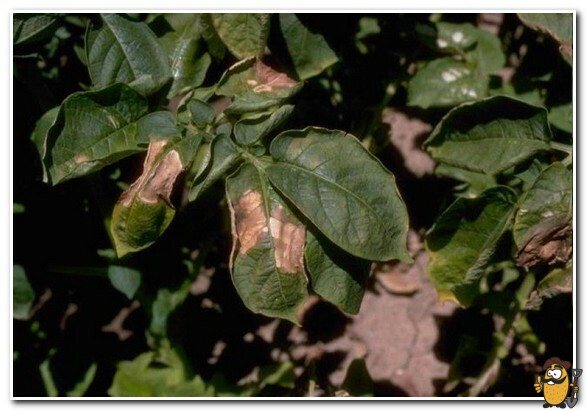

Fusarium potato: how to treat
For the treatment of this disease, 2 groups of drugs are used: chemical and biological. During the growing or storage period, you can process potatoes with such chemical remedies as Titus, Whist, Maxim. Opponents of chemistry use biologics. Fitosporin-M, Integral, Baktofit have proven themselves well. Use them before planting seed potatoes in the soil. All of these remedies are very effective in combating fungal diseases. They are sold in specialized stores, before use, they are diluted in water according to the instructions.
Fusarium potato and its control
Of course, the disease is easier to prevent than to waste time, effort and money to fight it. Therefore, it is better to take some preventive measures. It:
- planting healthy seed potatoes;
- buying varieties that are immune to dry rot;
- treatment of tubers with fungicides before planting and laying for storage;
- compliance with crop rotation;
- timely destruction of infected plants (at the initial stage);
- thorough disinfection of the soil when a disease is detected;
- application of mineral fertilizers and organic matter in optimal quantities.
Such preventive work will help prevent the appearance of fusarium on the site.
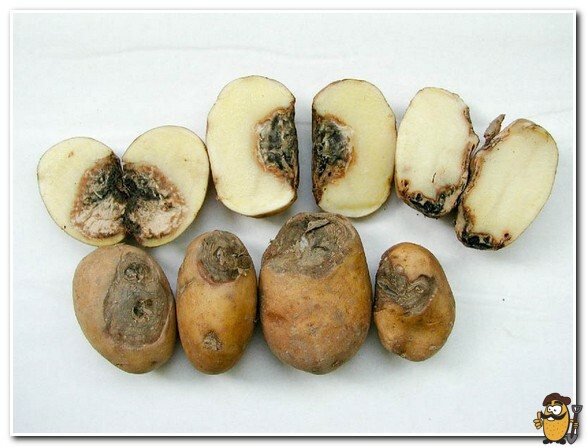

Measures to combat ring rot of potatoes
The main method of combating potato ring rot is to eliminate the source of infection, since, unfortunately, substances and preparations that can completely neutralize the action of this bacterium have not yet been identified. Therefore, it is important to follow simple agronomic measures for the preparation of seed tubers, tillage and subsequent planting of potatoes.
Agrotechnical measures
When planting potatoes, in order to avoid contamination of the future crop with ring rot, it is important to observe the following rules:
- for planting, it is better to choose more resistant potato varieties to this disease (mainly early varieties are considered susceptible to ring rot infection);
- the seed should be healthy, without signs of disease and deformation;
- tubers before planting in the ground must be warmed up in the sun for 2-3 days;
- if an infected bush is found, the plant should be dug out completely, capturing the adjacent soil around (the diseased bush should be destroyed away from the plantings);
- after harvest, to detect the disease, the tubers should be warmed up in the sun for 2 weeks.
It is important to carry out these agrotechnical measures in a comprehensive manner, otherwise you may not notice the spread of the disease in time, which will entail a sharp drop in yield.
Chemical and biological agents
In addition to the listed planting rules, chemical and biological agents help to fight potato ring rot.
One of the simplest ways to combat ring rot is the timely feeding of potatoes with potash and nitrogen-containing mineral fertilizers. Thanks to the introduction of these minerals into the soil, the immunity of the potato increases, and, consequently, its resistance to diseases, including ring rot. Vegetable crops should be fertilized with nitrogen fertilizers in the spring, and potash fertilizers by the end of summer.
In addition to timely feeding, potatoes should also be treated with general-spectrum insecticides, such as:
- "Sirocco";
- Tanrek;
- Borey Neo.
This treatment protects bushes and tubers from pests that cause mechanical damage to tops and root crops, making them vulnerable to bacteria.
Some gardeners recommend, before planting potatoes, to treat the planting material with the drug "TMTD", which has a complex spectrum of action against various fungal and bacterial diseases.
Attention! The drug "TMTD" has a 3rd hazard class, therefore it is important to observe the technology of application and use personal protective equipment during processing.
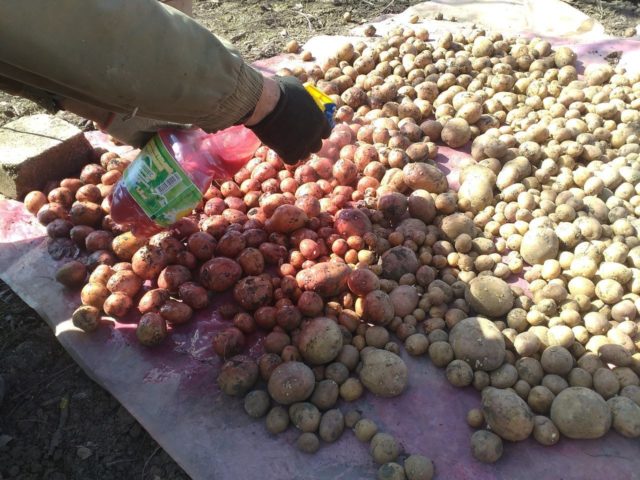

Traditional methods
Among the popular methods of combating potato ring rot, the main one is the disinfection of planting material. For this, a solution of manganese is used in the ratio of 1 g to 10 l of water. With this solution, gardeners recommend treating not only the tubers, but also the soil before planting.
If, after planting, the potatoes were nevertheless infected, then in this case quarantine is used, which consists in the timely destruction of the infected bushes. To do this, they dig out the affected potatoes along with a large earthen clod, then transfer the bushes away from the plantings and burn them. The remaining potato bushes are fed with mineral fertilizers to restore development and growth.
Also, the popular methods of combating ring rot include the timely destruction of pests, periodic weeding and feeding of potatoes. Helps reduce the risk of rot infestation and occasional haulm mowing.
Description of the disease
Ring rot of potatoes is dangerous because it affects both the tops and tubers.... Affected potatoes begin to rot before harvesting. And through the infected tops, healthy tubers are infected when they are dug up.
Characteristic
Ring rot is a bacterial disease, common in all areas where the crop is grown.
You can detect the disease by cutting the tuber... If the potato is infected, a vascular ring is visible under the skin. The fabrics in the area of the ring are soft and dyed yellow-brown. When pressed, light yellow mucus emerges from the affected tissues.


With the development of the disease, rot passes to neighboring tissues, covering the entire tuber... The flesh of a potato rots and turns into a slimy substance with an unpleasant odor.
Attention... The disease develops slowly. At the initial stages of development, the pathogen can only be identified by laboratory methods.
If you do not find the problem in time and do not take action, crop losses can be 40-50%.
Infected bushes dig up and destroy... It is no longer possible to cure these plants. Therefore, prevention plays a special role in the fight against infection.
Development conditions
Harmful bacteria thrive at moderate temperatures (from + 20 ° С) and high humidity. In heat and drought, the development of the disease is suspended.The main source of infection preservation and its transmission to new generation tubers is already infected tubers.
Causative agent
The causative agent of the disease is bacteria... It is noteworthy that they do not survive in the soil and are not able to winter in it. However, they remain viable in vegetable stores, on plant residues, in garden tools. But the main source of infection is infected tubers placed in storage.
The causative agent is capable of being dormant for several generations.until the right conditions for development come. Therefore, even from outwardly healthy tubers, diseased plants are sometimes obtained.
It can be useful:
What to do if the potatoes inside are empty
What to do if potatoes rot when stored in a cellar
How to get rid of weeds on potatoes using Lazurite
Transmission methods
Tubers become infected with bacteria during growth, in the early stages of tuberization... The causative agent of the disease from the vessels of the diseased bush through the stolons penetrates the potatoes of the new crop.
Another way bacteria can spread is through infection during harvesting.... The causative agent of the infection enters the surface of the tuber by contact with infected tops, cut diseased potatoes or tools used during harvesting.
During storage, healthy tubers can also become infected by contact with sick... Especially if the former have damage to the skin, scratches or cuts. For this reason, all damaged potatoes are stored separately from the main crop and processed first.
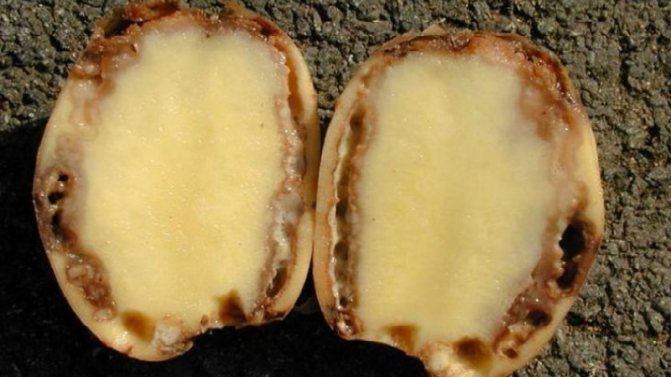

Forms of the disease
Ring rot develops in two forms: pitted rot and ring rot proper.
Pit rot is the primary form of the disease.... It develops when an infection gets on the peel of a potato during harvest (by contact with diseased tops or tubers).
In this case, rounded oily yellow spots 2-3 mm in size appear on the tubers during storage. Gradually, they grow up to 1–2 cm in diameter. At first, no symptoms of the disease are visible. The disease manifests itself only in March-April.
Attention... When the temperature rises (+ 18 ... + 20 ° C), the development of pitted rot intensifies.
If such tubers are not removed during preparation for planting, then the disease will progress and spread to young tubers.
The second form of the disease is actually ring rot.... It manifests itself in the form of necrosis of the vascular ring on a cut of a potato. The infection spreads from infected tubers planted in spring.
Fungal diseases of potato tubers during storage
Potatoes are affected by fungal and bacterial diseases during the growing season and during storage. Of the fungal infections, the greatest harm is caused by late blight, fusarium, alternaria.
Late blight
Late blight is one of the most dangerous fungal diseases. The fungus infects the crop even during the growing season (it is able to destroy up to 70% of the crop in a short period) and is transferred with tubers to storage sites.
Hard gray spots appear on the surface of the tubers, clearly visible on the pulp when the potato is cut. With the growth of the mycelium, the tuber begins to rot.
Protection and control measures
In case of damage to plants during the growing season, it is necessary to spray the potatoes with 2% raster Bordeaux liquid. If you suspect a complex lesion (that is, several types of fungal diseases) use biofungicides "Fitochit", "Fitosporin-M", "Planriz", etc.
Optimal storage conditions are good ventilation, lack of light, air humidity within 80-90%, air temperature not higher than + 2 ... + 3 ° С. For the development of phytophthora, a high temperature is required (+ 20 ... + 24 ° C). Therefore, it is not recommended to store potatoes in residential areas with high temperatures.
The best potato varieties resistant to late blight are: Lasunok, Temp, Scarlet, Aspia, Vestnik, Golubizna, Lugovskoy, Resource, etc.
Fusarium (dry rot)
Like late blight, it affects the tops and tubers even during the growing season. Excessive soil moisture (prolonged rains) at high temperatures contributes to the rapid spread of the disease.
During the growing season, external signs appear in the form of gray spots on the leaf surface, general wilting and drying of plants. The affected plant withers literally in one day. A striking feature of the defeat of the culture by Fusarium is a bluish-black ring on the cut of the stem (vessels clogged with fungal hyphae).
Tubers stored for storage are covered with a whitish bloom, or the skin in places where gray-brown spots are formed wrinkles and becomes dry (without obvious reasons for violating the rules for storing products). The section shows dark voids filled with mycelium.
Protection and control measures
The level of harmfulness is very high. The mycotoxins of this disease persist not only in the harvest, but also in processed products. They affect the human nervous system, cause the death of birds and animals. Tubers (like other products - flour, juices, jams, fodder for animals) affected by fusarium cannot be used for food.
During the growing season, plants are sprayed with a 1-2% solution of Bordeaux liquid, solutions of biofungicides (Fitosporin-M, Fitochit, Baktofit, Integral, Planriz).
The optimal storage conditions are the same as for protection against late blight. It is recommended to treat the tubers with Fitosporin when storing them (biofungicide does not affect human and animal health). Carry out a systematic bulkhead of potatoes (carefully so as not to disturb the outer skin, since the infection quickly spreads to neighboring tubers).
Fungal diseases
The culture is often affected by pathogenic fungi that enter the tubers through the damaged skin. They parasitize on the plant part and feed on its juices.
To reduce the risk of contracting fungal diseases, do not plant potatoes next to tomatoes and other Solanaceae.
Late blight
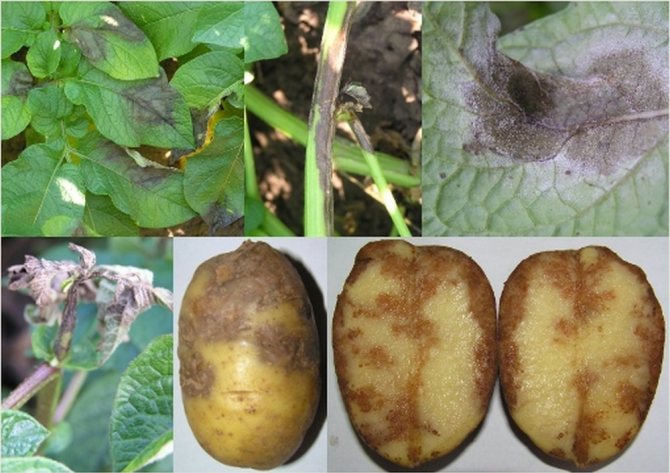

Tubers are attacked through cracks in the surface and rot in a couple of weeks
Potatoes suffer from this disease most often. If preventive and therapeutic measures are not taken in a timely manner, you can lose most of the crop. Late blight appears even during the flowering of the plant, especially at extremely high air humidity. Dark brown spots appear on the leaf plates, covered with a bluish bloom. Further, the fungus enters the tubers.
It is important to treat tubers with fungicidal preparations before planting and spray the plants with them throughout the growing season.
Black scab


The leaves are covered with brown specks on top, whiten below and brown spots appear on the tubers
This is a fungal disease that can kill young shoots. It can manifest itself not only in the process of growing potatoes, but also during storage. The provoking factors are high temperature and dampness (heavy rainfall or excessive watering). Spores of fungi, together with water, settle on healthy tops and infect it. The pathogen remains viable for a long time in the soil and tubers.
Prevention means following the rules of crop rotation and planting varieties that are resistant to this disease. In addition, the tubers must be treated with any fungicidal agent before planting:
- Maxim;
- Kolfugo;
- Ditan M-45;
- Quadris;
- Fitosporin-M;
- Fenoram Super.
Silvery scab
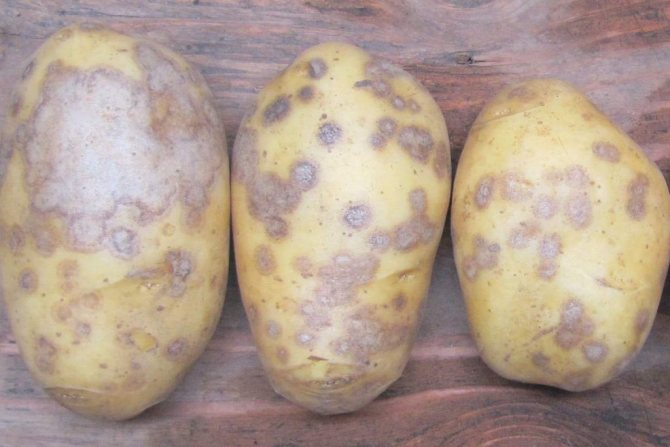

It is not difficult to diagnose a silvery scab; it is enough to take a potato in your hand - it will be light due to moisture loss
Usually the disease makes itself felt in the spring - its symptoms can be detected already at the stage of selection of planting material.In sick vegetables, the peel casts a silvery sheen. The pathogenic fungus is activated when storing potatoes in a room where the humidity is over 90% and the temperature is over +4 oC. Tubers affected by silver scab must not be used for food or for planting.
To prevent the development of the disease, before laying vegetables in storage, they should be treated with a fungicide and dried in the open air.
Powdery scab
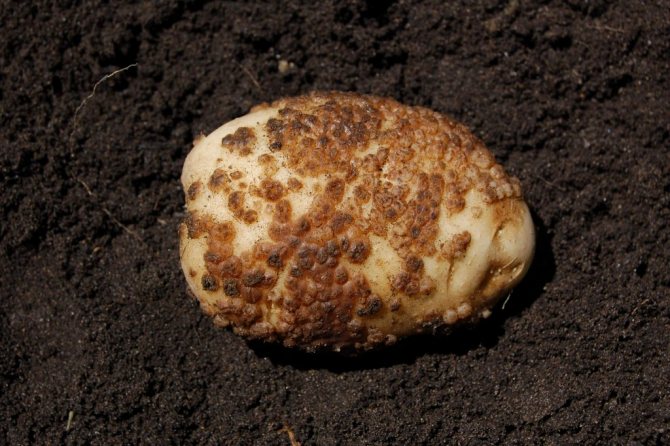

There are black sores on the tubers that can be easily removed with a fingernail.
The disease progresses in steadily rainy weather. When inspecting the bushes, a white fluffy bloom is found on the leaf plates, and the stem becomes thinner. Before pouring it into a vegetable store, it is recommended to process the tubers with a 3% solution of bleach or copper sulfate.
If you store sick potatoes with healthy ones, then the whole crop will inevitably deteriorate.
Potato cancer


Bumps grow on the tubers
This is the worst disease for potatoes and neighboring plants. If it is found, quarantine is imposed on the entire economy. Sick plantings are removed from the ground and burned outside the garden plot. The remaining plants are sprayed with fungicidal preparations, and the soil is watered with a solution of bleach. In the next 3-4 years, you should stop growing potatoes in this area.
Rejected potatoes, including tops, should not be fed to livestock.
Dry rot


Dry rot can destroy up to 40% of the crop
Dry rot in potatoes is also called fusarium wilt. The most favorable period for its distribution is the flowering of plants. The fungus multiplies especially actively in the heat. The disease can be detected by lightening and withering upper leaves, as well as brown stains on the stems.
Infected bushes should be immediately dug up and burned, otherwise the plants in the neighborhood will get sick. In the next 3 years, it is better to refrain from planting potatoes in this place.
Treatment
The fight against fungal diseases can be successful if it is started at the first signs.... Treatment of bushes usually helps with the following means:
- bordeaux liquid;
- copper sulfate;
- cuprosate;
- praline;
- bactophyte.
During the summer season, no more than four procedures are carried out and only before the flowering of the plant.
Prevention
Preventive measures for ring rot include the following:
- Purchasing quality planting material from trusted suppliers or using your own healthy potatoes from last year's harvest.
- Heating tubers in the sun both before planting and after harvesting. Since it is believed that ring rot bacteria are more pronounced at high temperatures.
- In early spring, it is advisable to plant mustard or oats at the chosen planting site.
- After harvesting, it is required to send it to storage in a clean and disinfected room. Therefore, before placing potatoes for storage, you should clean and formalin the room, and also thoroughly wash the container where the harvest will be folded. Proper ventilation of the room is also important so that condensation does not accumulate and mold does not appear.
- Crop rotation should be observed as a preventive measure. In case of infection of potatoes, it is advisable not to plant this vegetable crop in the same place for 3 years.
Such simple preventive measures allow you to maximally protect the future crop from this unpleasant disease, and also allow you to preserve healthy potatoes.
How to keep potatoes from rotting?
Based on the foregoing, it is clear that poor preservation of tubers in the cold period begins with a violation of the technology of growing and harvesting this crop.The following significant reasons are the unpreparedness of the storage (cellar, basement, vegetable pit, balcony, loggia, etc.) for storing products, incorrect selection of potato varieties, violation of the storage technology.
It is these reasons that cause damage to tubers with various fungal, mold and bacterial diseases; contribute to their rapid spread and loss of yield, not only during cultivation, but also during storage.
To protect potatoes from rotting during storage, it is necessary to properly prepare the site for this culture. Apply fertilizers, top dressing, carry out treatments for diseases and pests only in accordance with the technology and recommendations.
Read our detailed materials Features of growing potatoes: preparation and planting and Features of growing potatoes: agricultural technology.
For planting (for the purpose of long-term storage of tubers in the cold period), it is necessary to use only zoned, medium and late varieties (in terms of ripening), resistant to fungal and other diseases. Before planting, the seed must be processed.
Read our resource Proper Potato Treatment Before Planting.
During the growing season, the treatment of plants must be carried out at the very beginning of the disease, and not wait for mass destruction. It is more practical to carry out preventive treatments according to a previously worked out scheme.
Only absolutely healthy, undamaged tubers should be stored in prepared storage facilities.
Correct harvesting and storage is a guarantee of future harvest
An obligatory and basic method in the fight against bacteriosis is pre-harvest mowing of the tops. It prevents infestation of tubers during harvesting due to their contact with damaged tops. This activity should be carried out 7 days before harvest.
For seeds, it is necessary to select potatoes from externally healthy plants, therefore we advise you to mark such bushes before mowing the tops. Immediately after harvesting, the potatoes are dried in the field for three to four hours, this improves keeping quality, and the protection against damage by wet rot increases by 3-4 times.
It is not recommended to harvest potatoes in wet weather, since bacteria that cause black leg, ring and wet rot, under such conditions, easily penetrate the tubers through mechanical damage and lentils, causing their massive rot. After harvesting, place the potatoes in a shed and keep for 2-3 weeks at a temperature of 15 ° C.
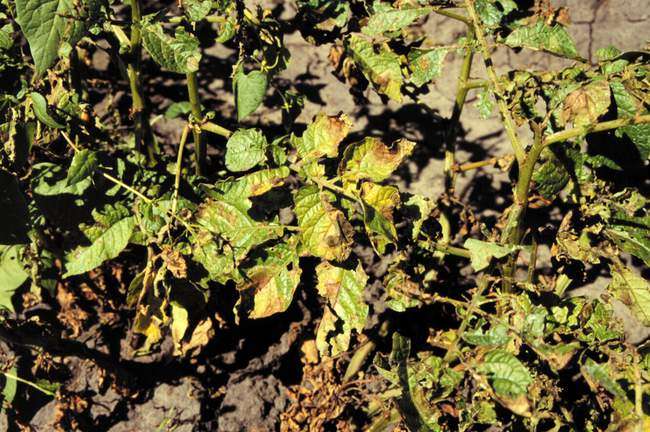

During this period, which is called therapeutic, latent infection will appear, ripening will occur and the storage capacity of the tubers will increase. Sort the tubers before storing them for permanent storage. At the same time, it is useful to plant greenery on seed tubers intended for planting next year within 3-7 days. This technique also inhibits the development of bacteriosis.
Storages (cellars, cellars, pits), no later than a month before laying the harvest for the winter, are cleaned of soil and plant debris, structures, walls of bins, storages, ceiling and shields are whitewashed with lime with the addition of copper sulfate (2-3%). The height of the embankment in the bins should not exceed one meter. On the surface of the embankment, in order to avoid sweating of the tubers, beets, previously cleaned from the ground, are laid.
In winter, the temperature in the storage should be at least 2.4 ° C. Compliance with all these rules will reduce the loss of potato yield from bacterial diseases and get better quality seed material for further potato production.
loading ...
loading ...
- Darkening of potatoes - occurs when exposed to very low temperatures below 0 ° C or high (more than 15-17 ° C for three months in a row) or with a lack of oxygen during storage. Putrefactive processes can develop on the surface and inside the potato.
- Gray spot - occurs when there are a lot of shocks during harvesting and storage, or when the harvest is too early, as well as when there is an excess of nitrogen and a lack of potassium in the soil during plant growth. Strongly reflected in quality - the spots darken when boiling potatoes.
- Suffocation of tubers - occurs when there is a lack of air in the storage. The tuber rind is covered with light tubercles, which subsequently develop into wet rot. One of the telltale signs of a strangulation of tubers is the smell of alcohol in storage.
- Freezing of potatoes - occurs at sub-zero temperatures, even the lowest, potatoes become pinkish, darken when defrosting and greatly lose quality.
- The appearance of voids on the cuts of the tuber - speaks of an excess of nitrogen and a lack of moisture during the growth of potatoes. When contaminated with bacteria, the voids quickly fill with rot.
- Greening of tubers - occurs when exposed to light. The extent of the process depends on the amount of light hitting the potatoes. Green potatoes become toxic and not edible, but plantable.
Blackleg
Blackleg develops under the influence of microbes that settle on weeds and then spread to vegetable crops. In this case, the activity of microbes remains at a temperature of 2 ° C to 32 ° C.
Signs
It is impossible to visually determine the presence of signs of damage to potato root crops in the early stages.
The black leg, according to the description, shows symptoms when creating favorable conditions for it in the form of increased dampness or excessive dryness. Moreover, among the most common signs of the presence of microbes are:
- blackening of the bottom of the potato bush,
- yellowing of leaves,
- general wilting of the plant,
- rotting tubers with darkened skin and cracks,
- liquid with a characteristic smelly odor.
As a result, in the root part, the black leg begins the process of softening the sprouts, the potato tubers become covered with black spots and begin to rot. Infected bushes can be easily pulled out of the soil layer. From the sections of the stems, mucous discharge is visible.
Wet bacterial rot
The most dangerous type of potato rot is caused by saprophytic bacteria that attack tubers weakened by other diseases and pests. The development of wet rot is facilitated by the cultivation of potatoes on waterlogged soils.
The disease manifests itself only during storage at too high a temperature in poorly ventilated storage facilities.
Symptoms The tissues of infected potatoes decompose, turning into a slimy mass with a pungent unpleasant odor. If a diseased tuber has overwintered, it may rot already on the field after planting (especially if the soil is cold).


Wet rot can be detected by an unpleasant odor.
Weak tubers are affected first: sick, damaged, frozen, then rot moves to healthy potatoes and also spoils it.
Prevention and Treatment. The only effective remedy for wet potato rot is proper storage of tubers at a temperature (+ 1-2 ° C) and normal ventilation of the vegetable store. In such conditions, bacteria remain inactive.
Rotten potatoes must be promptly removed from the storage (not only infected, but also neighboring tubers are removed).
Is it possible to eat affected potatoes
Tubers in which the disease has just begun to develop, are not dangerous to humans and are quite suitable for human consumption. In such potatoes, the dark ring under the skin is not yet pronounced and the pulp has not lost its taste.
Potatoes with strong signs of damage, a pronounced unpleasant odor and soft mucous pulp can no longer be eaten.
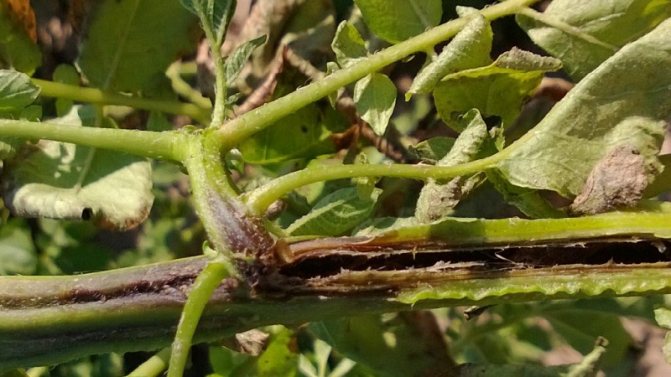

Because of what the vegetable rots before harvest
High humidity and a lack of nitrogen in the soil due to poor loosening or lack of fertilizers can lead to rotting of potatoes.A common reason is rainy weather, accompanied by an air temperature of + 20 ... + 25 degrees.
Rot can appear on potatoes planted on loamy soil, especially if its temperature is not higher than + 18 ° C, and the acidity is close to ideal for potatoes.
The appearance of rotten potatoes is also facilitated by sudden changes in temperature and dense planting. The disease can be provoked by the remnants of potato tops or tubers not harvested during the last harvest.
Attention!
These reasons can also lead to serious diseases, including alternaria, late blight, black scab (rhizoctonia).
The plant will start to rot if you pick up the wrong planting material, among which there were infected vegetables.
Preventive measures
- With the correct crop rotation, all infections are often eliminated.
- It is not necessary to apply a large amount of fertilizer to the ground.
- Tops and weeds should be removed from garden areas to avoid re-infestation.
- Before planting tubers, they should be processed.
- It is advisable to choose varieties that are more resistant to infections.


If it was noticed that the potatoes picked up an infection during storage, then a few months before placing a new crop there, they should be treated with fungicides. This should be done in advance so that the product does not end up on the crop.
After digging up the crop, it is recommended to dry it well and sort it out. In order for the infection to stop developing, it is advisable to sprinkle the potatoes with ash. This will help keep it well and stop the infection from multiplying and infecting other tubers.
We increase plant resistance
In the fight against potato diseases, all the methods aimed at increasing the resistance of plants and the destruction of pathogens are important. Selection for planting healthy seed is of great importance. In the spring, three weeks before planting, seed tubers are taken out of storage facilities (basements, cellars, pits) and placed in a warm room with a temperature of about 15 ° C. At the same time, you should carry out light hardening of the seed material (gardening), germinating it in diffused light. This technique will increase the field germination of tubers, reduce the development of bacteriosis during the growing season and thereby increase the yield.
During the period of spring light hardening - germination, all bacterioses and other diseases appear on the tubers. At the end of spring germination, before planting, the seed tubers are sorted out, all rotten and affected tubers are removed. If the planting is delayed or the potatoes grow prematurely (the sprout length is more than 5 mm), they are again placed in the cellar and stored at a temperature of 2-3 ° C. In this case, the germination of potatoes is maintained. For planting, it is necessary to use dry, poorly sprouted tubers with a sprout length of up to 5 mm.
Effectively increases the resistance of potato plants to scab and other diseases, strengthens their immunity and stimulates growth, treatment of tubers before planting with a growth regulator - a biological preparation AGAT-25K. The main active ingredient of this drug is beneficial soil bacteria - natural antagonists of pathogens. This preparation also contains a physiologically balanced set of starting doses of macro - and microelements, vitamins B1, B2, PP, as well as special biologically active substances from seedlings of various plants that improve the immunity of potatoes. It is allowed to process tubers with small sprouts. This preparation is very economical to use: its consumption is only 7 g per 100 kg of seed tubers. Potato tubers are treated by spraying (1 liter of working solution per 100 tubers). It should be noted that AGAT-25K is compatible with fungicides - chemical agents for protecting against plant diseases. Copper sulfate can be added to the AGAT-25K working solution at the rate of 0.02 g per 100 kg of tubers.
Preparations for prophylaxis
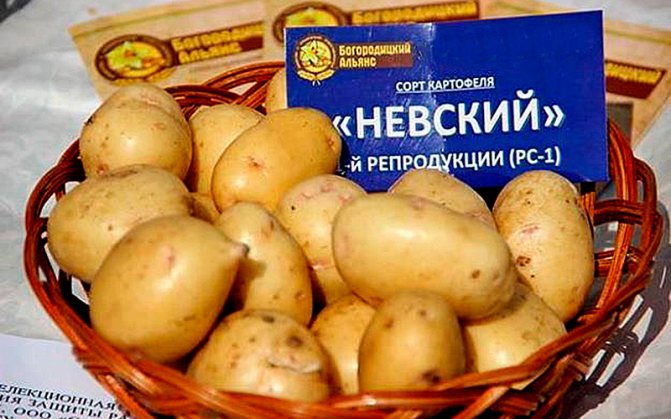

Measures to combat the disease are ineffective, there is no cure for it.At the same time, experience shows that the use of aqueous solutions of biological preparations reduces the likelihood of disease. These means include "Maxim", "Quadris", "Gamair". They are used to process tubers before planting or storage.
There is another similar drug, but it makes sense to use it only before planting. This is the TMTD fungicide.
The rules for the preparation of aqueous solutions of these drugs are always attached to each package, they should be strictly observed.
But the varieties that are resistant to ring rot: "Bronnitsky", "Nevsky" (but these 2 varieties are susceptible to damage by a black leg), "advanced", "root".
Alternaria (dry spot of potatoes)
In terms of the level of damage to potato yields, this disease is similar to late blight. It affects all parts of the plant (stems, leaves, tubers). Most often, it is the middle and late varieties of potatoes that are affected by dry spotting, that is, those recommended for laying for winter storage.
Alternaria (dry spot of potatoes).
The lesion during the growing season manifests itself on leaves and stems in the form of large concentric spots. The spots gradually acquire brown or dark brown color with a brown tint. Depressed spots appear on the surface of the tubers, which gradually wrinkle. On the cut of the tuber, the affected areas are necrotic, differing from healthy tissue in hard, dense pulp of black-brown color.
Manifestation of the disease
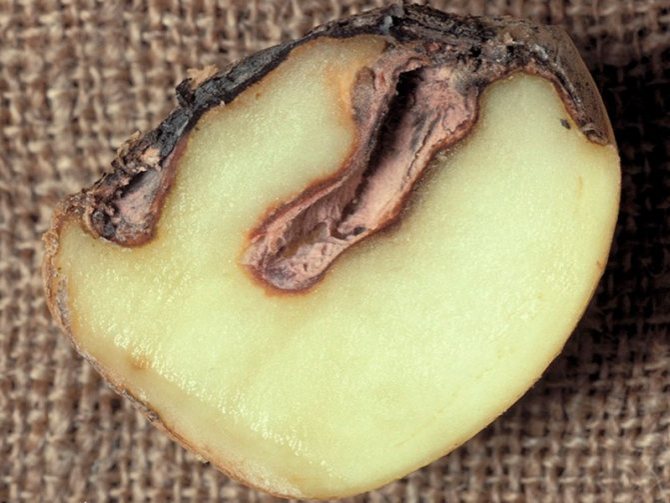

If there are spores of dry rot fungus in the soil where potatoes grow, then sooner or later, together with life-giving moisture, they enter the structure of the plant. For this reason, small whitish spots appear on the tips of the leaves (you can see them in the photo).
After a short time, a pinkish bloom appears on the potato stems. Further, the mycelium begins to grow and thereby block the access of useful substances to the stems and leaves of potatoes. The development of the bush slows down, the tops on it wither, and then the leaves fall off. The bush soon dries up completely.
Infection conditions
Wet rot potatoes can become infected even in the garden or in storage. In this case, special conditions are required:


- Bacteria that cause wet rot usually enter tubers due to mechanical irritation of the peel by pests and other diseases. Ring rot and black leg are most often the precursors of wet rot. It is also common for potatoes to become infected as a result of irritation of tubers by wireworms.
- Wet rot develops best at storage temperatures above 5 degrees Celsius. If potatoes are piled up in large piles and in places where there is high humidity and air temperature, then the disease will very quickly spread throughout the potatoes. In places of an outbreak of the disease, the temperature, due to the vital activity of bacteria, can rise to 50 degrees Celsius. In such places, potatoes quickly rot.
- When the tubers are suffocated, outbreaks of wet rot often occur. The tubers do not have enough oxygen, and the high content of carbon dioxide weakens the immune system. Therefore, in storages, potatoes should not be placed on large piles and ensure reliable ventilation in the room. Strangulation can also occur in soil if the soil is moist and very dense.
- Wet rot develops best in potatoes that have been supercooled at temperatures close to zero. Potatoes that lay at temperatures below 0 degrees cannot be stored; they must be isolated and used as soon as possible.
Form and symptoms
The activity time of potato ring rot is the entire growing season of the crop. The first signs appear in the second phase of the growth of the bush. How the disease works:
- moves from the mother tuber to stems and leaves;
- clogs blood vessels, disrupting the flow of water;
- the plant withers, loses color;
- if the cut of the stem is dipped in water, salt will stand out.
Ring rot of potatoes is easy to identify by the tubers.A brown loose ring is visible on the cut at a short distance from the hide. At first, it is slightly slimy, then, with the development of the bacterial population, it captures the entire potato. If you cut a heavily affected tuber, a slimy mass is released from it.
If the planting material is affected in its initial forms, then it is impossible to determine the disease by external signs or by touch. Therefore, there is a high probability of bacteria getting into the soil.
Dwarf and diseased plants grow from diseased planting material, which do not give a good harvest. Also, the infection is transmitted latent to daughter tubers.
The disease manifests itself both on the tubers and on the ground green part of the potato bush. The main symptoms of ring rot are:
- On tubers, the manifestation of the disease is not easy to notice without violating the integral structure of the tuber, that is, it must be cut. When cutting the tubers, you can see yellow or already brown rings that will cover the area close to the skin.
- Under favorable conditions, infected tubers can completely rot, while pressing on the tuber will release a slimy mass.
- External signs of the disease can appear under favorable conditions for the development of the virus in the middle of the tubers. For this, the planting material is warmed up at temperatures from 15 to 18 degrees Celsius.
- On the herbaceous part of the potato bush, the disease manifests itself in the period after flowering. At this time, thin stems on infected bushes begin to turn yellow. Leaves also curl and turn yellow. Such stems do not pull out well and gradually die off. This dying off is explained by the destruction of the vascular structure of the potato (first the tubers, and only then the stems).
- When planting heavily infected planting material, some of it will rot in the soil, and some will sprout. Such seedlings will be dwarf and poorly developed. Infected bushes have thin stems and small, close-knit leaves.
- If from year to year your planting material produces less and less shoots, it must be replaced, since, most likely, the potatoes are already infected with ring rot.
How to deal with fusarium
Pathogens live in various types of soil. Most often, they manifest themselves only under favorable conditions. Most of all they love the land, which is rich in nitrogen and perfectly fertilized with manure. Therefore, it is not recommended to often apply organic fertilizers, so as not to get into trouble.


Spores, which constantly sleep in the soil, begin to penetrate the potatoes through wounds and cracks under favorable conditions. As a result, the disease begins to develop rapidly, gradually affecting the roots, leaves and stems. After flowering begins, Fusarium wilting can be observed in plants.
The leaves at the tips gradually brighten, whitish spots appear, and as a result, the stems are gradually affected. The outer part of the plant is covered with a bloom of pink, and then affects the inside. It can be seen when cut, it changes color in the first stages of development. After that, the growth of the potato becomes slower, and as a result, it withers.
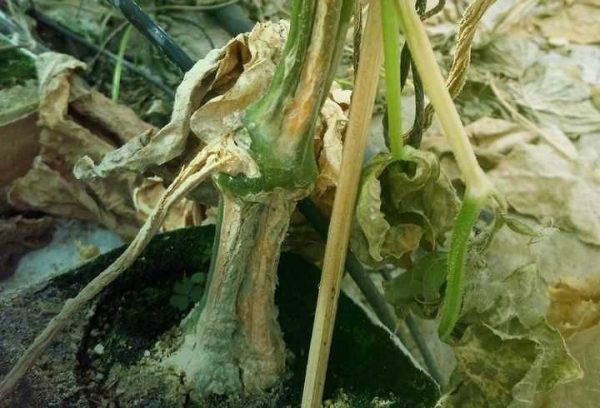

Dry rot does not necessarily spread during the early stages of potato development. Every seasoned grower can dig up a pretty healthy potato and leave it to be stored. After a few months, the tubers are covered with small specks of brown color, then they increase in size and fall out. Subsequently, it becomes like a light but hard ball.
Unfortunately, the disease cannot be cured. You can take preventive measures, stop the spread, but those tubers that are already affected will gradually deteriorate. In addition to all this, the infection carries with it other fungi, which deprive the gardener of a large share of the crop.
If the disease is already in the ground, then it requires careful processing.You can plant green manure in the required place, as they perfectly nourish and clean the soil. It is desirable to treat it with phytosporin.


It is recommended to abandon organic fertilizers, or reduce part of the application. Fresh cow dung is not advisable.

